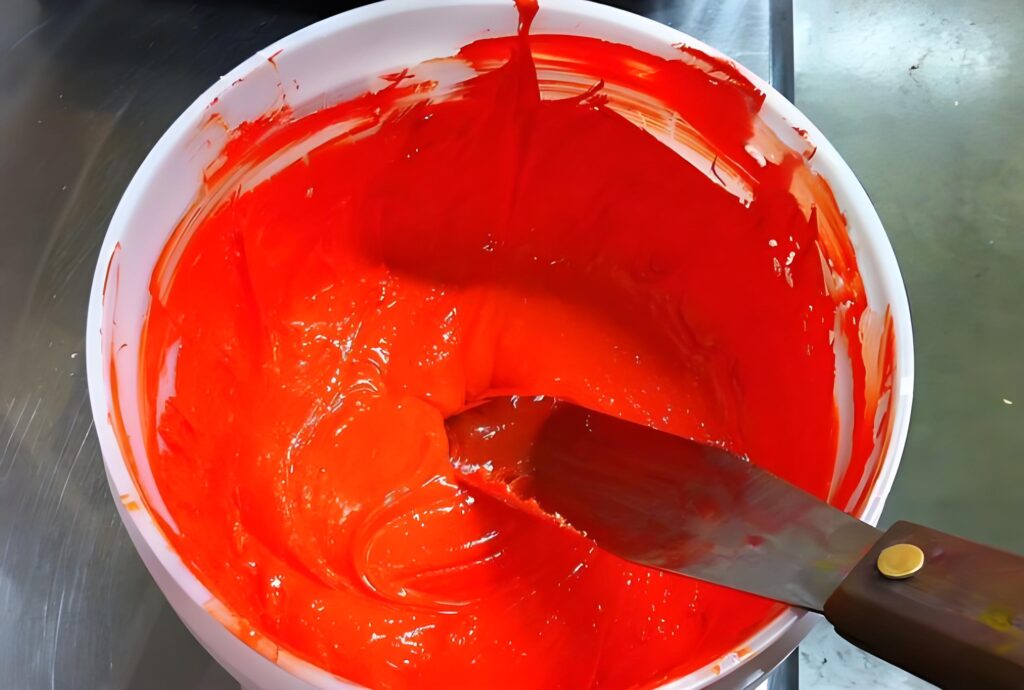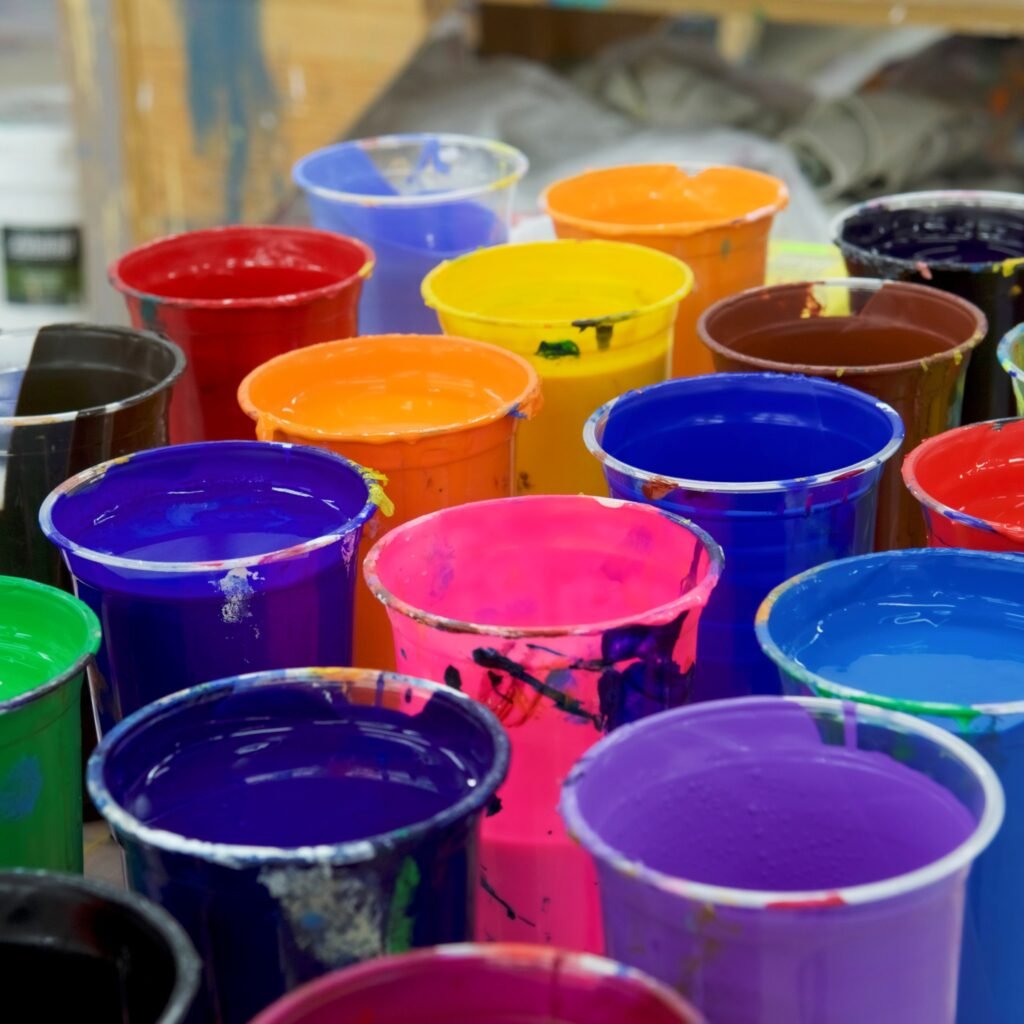Punktopsummering: Vigtige erfaringer med serigrafi med blæk, Plastisol-blæk og 7606 National Red
- Blækpræference styrer dækning, opacitet og livlighed – vælg den rigtige metode til jobbet.
- Plastisol-blæk giver unikke forarbejdningsfordele: behøver ikke lufttørre, blød hånd, bedst til fugtigt-i-fugtigt og farver med høj ydeevne.
- 7606 landsdækkende lilla plastisolblæk giver ekstraordinær livlighed, dækning og kaffeblødning, især på mørke stoffer og polyester.
- Korrekt behandlingstemperatur og hviletid er afgørende; brug en vasketest for hver produktionskørsel.
- Lavt blødningsniveau og underbaseteknikker er afgørende for polyester og sweatshirts for at forhindre farvemigration.
- Netpålid og gummiskraber, valgfri form, blækaflejring og tryklæsbarhed.
- Emulsions- og coating-picks har en effekt på printdetaljer, genvindingsydelse og produktionshastighed.
- Omhyggelig brug af reduktionsmidler/tilsætningsstoffer kan forfine blækkets egenskaber, men bør afbalanceres for at undgå udflåd og tab af opacitet.
- Flash-print og blæk med høj opacitet får flerlagsprint til at fremstå tydeligt, primært ved brug af levende farver.
- Opbevar blæk ved stuetemperatur, brug det inden for 365 dage, og genbrug skærme med det samme for at bevare deres gode kvalitet.
Brug disse idéer, og dit eventyr gennem blæk-, plastisol-blæk- og den ikoniske 7606 nationale røde arena vil være ren, farverig og konstant et hit.
Mastering af serigrafi: Din komplette guide til blæk, Plastisol-blæk, 7606 National Red, hærdning og meget mere!
Er du klar til at låse op for hemmelighederne og teknikkerne bag de bedste resultater af serigrafitryk ved hjælp af blæk, plastisol-blæk og især den legendariske 7606 nationalrød? Uanset om du er en erfaren professionel eller lige er begyndt med serigrafitryk, vil du finde ud af, hvorfor teknologisk behandlingstemperatur, valg af den rigtige belægning og arbejde med lavblødende internationale belægninger kan være forskellen mellem middelmådige tryk og smukke, farverige farver. Denne artikel vil dykke ned i hvert element, fra at vælge den bedst egnede mesh til at perfektionere din underbase, med fokus på rød plastisol-blæk for resultater med høj ydeevne. Hvis du er serigrafitrykker og leder efter kvalitetsresultater til mørkt stof, sweatshirts, polyesterblandinger og mere, er dette den hjælp, du har brug for. Fyldt med praktiske tips, videnskab og svar på de mest stillede spørgsmål, vil du forandre dine trykresultater. Det er værd at læse, fordi hvert tryk, du producerer, fortjener at være perfekt - og denne guide viser dig, hvordan du opnår netop det.
Artikeloversigt
- Hvordan påvirker blækvalg resultaterne af serigrafi?
- Hvad gør Plastisol-blæk til det foretrukne valg til serigrafiprintere?
- Lås op for kraften i 7606 National Red: Hvorfor er denne røde blæk så speciel?
- Hærdningstemperatur: Hvad skal du vide for at undgå udskrivningsfejl?
- Hvorfor er valg af stof vigtigt ved tryk med rød Plastisol-blæk?
- Sådan kontrollerer du farvemigration og får lavt udblødningsniveau på polyester og sweatshirts
- Den ultimative guide til net, gummiskraber og blækaflejring
- Boost dine resultater med den rigtige coating og emulsion
- Sådan formulerer og bruger du korrekt reduktionsmidler/tilsætningsstoffer for at opnå de bedste resultater
- Hvad er vigtigheden af flashprint, underbase og høj opacitet?
1. Hvordan påvirker blækvalg resultaterne af serigrafi?
Enhver printmission begynder med et vigtigt valg: hvilken blæk der skal anvendes? Blækkets egenskaber, fra viskositet til pigment, har indflydelse på hvert punkt – blækaflejring via nettet, brodannelse mellem stoffibre og endda håndfølelsen af det færdige beklædningsgenstand.
Højtydende farvestoffer opnås ved at vælge den rigtige farve til materialet og trykønskerne. Til mørkt stof ønsker man for eksempel en uigennemsigtig farve med høj opacitet for at få levende farver, der skiller sig ud, hvilket betyder, at ikke alle serigrafifarver er skabt lige. Den legendariske 7606 landsrød er en rød plastisolblæk Formuleret til direkte tryk og anerkendt for sin farverige farvetone og avancerede dækning.
Valg af blæk styrer desuden vigtige faktorer som blødningsmodstand (lav blødning), farvemigration og produktionshastighed. Ftalatfri blæk, der i stigende grad kræver beskyttelse og overholdelse af standarder, påvirker også din printkvalitet og -proces, især for internationale belægninger og regler.
2. Hvad gør Plastisol-blæk til det foretrukne valg til serigrafiprintere?
Plastisol-blæk dominerer serigrafibutikker med rette. Det er cremet og kortvokset, hvilket gør det glat at trykke med og giver en blød følelse på det færdige beklædningsgenstand. I modsætning til vandbaseret blæk lufttørrer plastisol ikke, hvilket giver displayprintere frihed til at sætte produktionen på pause uden at bekymre sig om blækkets tørring i nettet.
Serien af plastisol-blæk, ligesom dem fra internationale coatings, tilbyder ensartet samlet ydeevne og kan bruges til vådt-i-vådt-tryk med høj hastighed. De er yderst gode til at opnå et blødere tryk på lysere tøj eller til at bevare livligheden på mørkere tøj, især når man bruger en underbase til tryk. Derudover er plastisol-blækformuleringer velegnede til forskellige masketal og kan forlænges med fortynder eller andet tilsætningsstof, hvis det er nødvendigt for at opnå præcise resultater.
En vigtig egenskab er, at plastisol-serigrafifarver bedst behandles ved den rette temperatur, hvilket gør håndtering af genbrug og rengøring nemmere: Indtil de er varmehærdede, kan du nemt undgå fejl med trykvask eller blæknedbrydningsmiddel.

3. Lås op for kraften i 7606 National Red: Hvorfor er denne røde blæk så speciel?
7606 countrywide crimson plastisol-blæk er berømt for sine livlige farver og høje opacitet, der skiller sig ud, uanset om du trykker sports-, reklame- eller detailtøj. Det er formuleret til direkte tryk og berømt for sin evne til at dække mørkt stof, hvilket gør det perfekt til hold, der ønsker ægte røde farver, der springer i øjnene.
Denne blæk er en del af en bredere serie af højtydende farver i 7600-kollektionen af plastisol-blæk. En bemærkelsesværdig egenskab er dens lave udblødningsevne, der hjælper med at reducere farvestofmigration – især vigtigt ved tryk på polyesterblandinger og sweatshirts. Den har også en cremet og let konsistens, så serigrafiprintere finder den let at trykke med og kan opnå glatte håndtryk, selv med tykkere blækaflejring. Den ftalatfri formelmetode går ikke på kompromis med ydeevnen.
For at opnå behagelige resultater og livlighed med lyserød plastisol-blæk som 7606, skal du altid bruge et net, der passer til maleriets detaljer, og bruge en hvid underbase for maksimal opacitet og lysstyrke på mørkere tøj.
4. Hærdningstemperatur: Hvad skal du vide for at undgå udskrivningsfejl?
Lad os tale om behandling: Det er den afgørende faktor for serigrafiens holdbarhed. Plastisol-blæk skal opnå en bestemt behandlingstemperatur (normalt 160 °C) for at hæfte sig perfekt til stoffet. For lav temperatur vil dit tryk revne, skalle af eller vaskes ud; for høj temperatur vil du risikere at varme tøjet op eller øge problemer med farvemigration.
Overvej din tørretumbler: Den skal opnå og opretholde den ønskede temperatur under hele blækkets aflejring, idet der tages højde for tøjets tykkelse (sweatshirts kræver længere hviletid end lette t-shirts). Brug en vasketest for at sikre, at dine udskrifter kan holde til vask. Hvis et udskrift fejler – revner, skaller af eller flager – skal du kontrollere dine tørretumblerindstillinger og sørge for, at stuetemperaturen er optimal, og at det ikke udsættes for træk, da miljømæssige udsving kan påvirke hærdningskonsistensen.
Lavere behandlings- og lavblødningsfarver er tilgængelige til varmefølsomme materialer. For eksempel, når man trykker på polyester eller blandinger, kan brugen af lavt behandlet farvestof hjælpe med at forhindre farvestofmigration ved at reducere temperaturindstillingen.
5. Hvorfor er stofvalg vigtigt ved trykning med Rød Plastisol-blæk?
Ikke alle stoffer tager blæk lige meget. Polyester, bomuld og blandinger interagerer hver især på en anden måde med plastisol-blæk, hvilket påvirker vedhæftning, udblødning, opacitet og hærdning. Bomuld giver normalt stærk blækpenetration og vedhæftning, hvilket giver en skånsom og nem løsning. Polyester er dog kendt for problemer med farvestofmigration – farvestoffer i tøjet kan bløde ind i plastisolen, især med røde farver, hvilket resulterer i misfarvning og ghosting-resultater.
Brug af lyserød plastisol-blæk på polyester, der er baseret på en lavblødningsformel og ofte et underlag (især vigtigt med 7606 landslilla). Til sweatshirts og andet tykt tøj gør en høj opacitetsblæk og en velafstemt blækaflejrings- og hærdningstemperatur hele forskellen.
For at reducere problemer ved serigrafitryk på blandinger eller polyester, skal du altid bruge maskestørrelser, der tillader tilstrækkelig blækaflejring uden oversvømmelse, og huske en print-flash-print-metode for at opnå gode resultater.
6. Sådan kontrollerer du farvemigration og får lavt udblødningsniveau på polyester og sweatshirts
Farvemigration er en plage for alle serigrafitrykkere, der arbejder med polyester- eller blandingsstoffer. Det sker, når farvestoffer i materialet migrerer ind i blækket og gør det rene hvide karminrødt eller giver din farverige 7606 countrywide pink en mørk nuance.
Lavblødende plastisolblæk er formuleret til at bekæmpe dette ved at blokere farvestof fra at trænge ind i blækaflejringen på et tidspunkt i hærdningen. Det er også vigtigt at bruge en hvid underbase – dette fungerer som en buffer mellem materialet og de øverste farvelag. Hold din behandlingstemperatur så lav som muligt uden at gå på kompromis med blækkets samlede ydeevne, og undgå overdreven varme. Husk, at det er vigtigt at reducere behandlingsblæk og at indstillingerne for korrekt tørretid og opholdstid er korrekte, især med sweatshirts og tykt polyestertøj.
Tjek altid det færdige beklædningsgenstand efter vask, tjek og opbevar ved stuetemperatur for at undgå problemer med trykbehandling. Serigrafitrykkere, der følger disse råd, producerer altid skarpe, levende farver - uanset underlaget.
7. Den ultimative guide til net, gummiskraber og blækaflejring
Den anvendte maskestørrelse styrer mængden af blæk, der passerer gennem skærmen, hvilket påvirker hver dækning og detalje. Finere maskestørrelser er ideelle til indviklede designs eller tyndere blækfilm, mens grovere maskestørrelser giver mulighed for større blækaflejringer, der ønskes til dristige udskrifter, og høj opacitet med lyserød plastisolblæk.
Dit valg af gummiskraber og perspektiv bestemmer blækaflejringen og fotoskarpheden. En skarpkantet gummiskraber trækker blæk helt gennem nettet uden ekstra midler, hvilket balancerer dækning og håndsans. Husk: Hastigheden og belastningen på dit strøg kan påvirke klæbeevnen og hvor nemt det er at genvinde skærmopsætningen.
Højtydende farver ligesom 7606 Countrywide Purple er afhængige af forholdet mellem net, gummiskraber og blækmetoden, primært på hårde stoffer som sweatshirts eller polyester med højt blodtryk.
8. Boost dine resultater med den rigtige coating og emulsion
Dit serigrafiresultat handler ikke kun om blæk og materiale: valget af belægning (emulsion) er afgørende. Emulsionen bestemmer, hvor godt nettet holder elementet, modstår underbase- og flash-printcyklusser og modstår blæknedbrydning.
For stærke røde og mørke underbase-malinger, brug malingsprodukter, der er godt afstemt med rød plastisolblæk, og sørg for, at din emulsion kan modstå gentagen eksponering for tørretumblere og trykvask. Korrekt overfladebehandling garanterer skarpe stencilkanter og reducerer blækkets nedbrydning og klæbrighed over lange udskrivningskørsler.
Hvis du planlægger at bruge højhastigheds fugt-på-fugt-tryk – det er ikke usædvanligt med plastisol-skærmtryk – så vælg en stærk emulsion for at opnå tilfredsstillende resultater og levende farver, selv med hyppige genbrugs- og genpubliceringscyklusser.

9. Sådan formulerer og bruger du reduktionsmidler/tilsætningsstoffer korrekt for at opnå de bedste resultater
Nogle gange kræver dit blæk justering. Måske er blækaflejringen simpelthen for tyk, eller også er klæbeevnen for høj, hvilket gør det svært at opnå en glat overflade. Tilsætning af fortynder eller andre tilsætningsstoffer kan hjælpe. Men at tilsætte en for stor mængde fortynder kan forårsage problemer: reduceret opacitet, forbedret farvemigration eller kompromitteret vedhæftning.
I tilfælde af 7600-serien af blæk skal brugen af et reduceringsmiddel eller andre ingredienser for at opnå en blødere oplevelse afbalanceres. For meget kan føre til 7600-serieblæk, hvilket kan forårsage problemer med gentagen farvemigration, især på mørke stoffer eller tøj med højt polyesterindhold.
Når du skifter blæk med en reducer, skal du regelmæssigt køre en test og en vasktest inden fuld fremstilling for at sikre, at trykket holder og bevarer den levende farve.
10. Hvad er vigtigheden af flashprint, underbase og høj opacitet?
Til flerfarvet eller mørkt beklædningstryk er det en trend at bruge et underlag: normalt danner en hvid underbase et grundlag for farverige nuancer, som 7606 landlig lilla, der fremstår.
Flash-print (hærdning af underlaget lige nok til at give plads til ekstra lag ovenpå) muliggør vådt-på-fugtigt-print, hvilket fremskynder produktionen uden at gå på kompromis med det bedste resultat. Blæk med høj opacitet sikrer, at du får en solid dækning, selv på mørke stoffer og underlag. Brug af en print-flash-print-metode kan hjælpe med at opnå en jævn, holdbar nuance med meget mindre blækaflejring og en blødere finish på det færdige beklædningsgenstand.
Husk, at den korrekte opacitet minimerer udblødning og maksimerer livlighed, hvilket er vigtigt for at opnå behagelige resultater med serigrafifarver på både bomuld og polyester.



